Program Brief: Arts Management Program
August 8, 2010
A message from the president of the graduate arts management society
The Arts Management MA program consists of approximately 100 multi-cultural students who spend a majority of their time on the Arlington Campus. With focuses in visual and performing arts, the students often find careers at museums, theaters and other arts venues after graduation.
The Graduate Arts Management Society is an elected group of students who work to compliment the academic experience by helping to establish a variety of cultural, social and recreational programs for the Arts Management students.
These programs provide the opportunity to balance course work and free time as cooperative factors in education.
To find out more about the program, visit http://artsmanagement.gmu.edu/welcome.htm or e-mail the Graduate Arts Management Society members at graduateartsmanagementsociety@gmail.com.
Virginia Case
President of the Graduate Arts Management Society
Economist muses on cause, solutions to jobless recovery
Fairfax, Va.— V, U, W, L. The first slide of professor Tyler Cowen’s presentation on the recent financial crisis appeared as if it were an eye doctor’s chart.
Cowen explained these letters are actually shapes that appear in economic data graphs during a recession, mentioning that the current pattern is in the shape of an “L.”
The March 29 event, part of the George Mason University Vision Series, captured the imagination and attention of over 250 Mason community members in attendance at the Center for the Arts. For Cowen, an author, economist and media contributor, the jobless recovery appeared to be a natural progression of many complex factors.
“People think that there is some big recession that started in 2007, and in 2006 things were great,” Cowen said. “This entire decade there has been no job growth at all.”
Cowen claims that what has taken place since 2007 is different than what happened after the Great Crash of 1929. During this recession, “a lot of people are underemployed — but there are those worse than unemployed…who say ‘No, I’ve given up!’” and are categorized as discouraged workers.
Cowen also said, “40 percent of those unemployed have been unemployed for over half a year. We’re not used to [a recession] being so persistent and lasting so long.”
In his presentation, Cowen noted a trend showing that younger people are waiting longer to get married. As with jobs, “people are searching more, and they care about the quality of a match,” he said.
So where is the money coming from now for consumption? According to Cowen, access to cheaper resources now means things can get done quicker for less, even as the labor pool dwindles. Those earning less than $12,000 per year have an unemployment rate of more than 30 percent, compared to the 3.23 percent faced by top earners.
With labor jobs going to India and China, what of our labor force?
“People in the eighties blamed the problems on Japan; in the last decade, we blame it on China,” said Cowen, who compared our shedding of labor jobs to the recent trading of several prominent members of The Washington Wizards who were let go to save on the pay of their exorbitant salaries.
Cowen thinks innovations like Twitter are useful towards creating jobs and making innovations in the marketplace happen, even if they have not quite figured out a way to make a profit yet.
Yoanna Ganeva, managing director of Mason’s Interdisciplinary Center for Economic Science (ICES) Program Lab, enjoyed Cowen’s approach to the complexities of the financial crises, and was interested in his ideas of “ways to integrate the immigration issues our country faces as part of helping our economy’s recovery.”
Cowen ended his lecture by speaking about John Stuart Mill, and his concept of the “Stationary State” introduced in 1848 and the “techno-utopia” of the recent past decade.
For Cowen, technological changes are imminent. He said we are already living in a “technotopia” with the advent of the Internet, blogs and cell phones. So, job seekers be warned: the job revolution of the future will be created by the innovators of today.
George Mocharko, Stylus Staff Editor
Treating the Symptoms, Not the Problem
August 8, 2010
Student loans – a conservative view
The new student loan reform legislation that was passed with the health care reconciliation bill is another liberal travesty to pile on board previous legislation that attempts to deal with higher education (along with education, in general). With this bill, the federal government becomes the primary lender of student loans, replacing the private industry. Like most other problems, liberals believe the answer is either the replacement of private industry with the government, or to make the private industry utilities of the federal government (as seen with the recently passed health care legislation).
In doing this, liberals can expand power and pretend to attack a problem, while in reality, they are only addressing the symptoms. Rather than focus on the rising costs of education, they go after private industry. (This is, again, seen similarly with the health care bill, in which liberals deal with insurance companies rather than deal with the costs of health care). Now, Congressional Democrats’ only accomplishment is in making it easier for students to take on debt that will plague them and the American taxpayer. Unless one takes the noble step of going into public service (in which case your debt will be forgiven after 10 years), it will still be a burden to the American taxpayer.
The growing influence of the federal government over higher education has produced a negative result rather than a positive one. From 1965 to 2007, federal spending on higher education rose from $7.5 billion to $36.6 billion. From 1982 to the present, education costs have risen 439 percent. Throughout this time, the cost of higher education has skyrocketed. The answer to the cost question of higher education may very well lie in rolling back federal support for institutions, as a report by the Cato Institute argues.
The key issue comes down to supply and demand. More and more Americans want to acquire a college education. As demand increases, a shrinking supply means that prices also increase. New colleges are established, and older schools will be expanded to meet the growing demand. In the meantime, some Americans will postpone college, since one can go to college at any time in his or her life. Eventually, the supply expands to the point where it exceeds demand and prices begin to fall. Now, those who could not afford to go at an earlier time period are now able to get the college education they desire.
However, when third parties, such as the federal government, interfere with student aid, prices are distorted, the budget constraints are not as great and colleges and universities need this cushion to continue raising costs. Students are still willing to attend because of aid or easy credit, putting them at a distinct advantage, finishing school with massive debt. William Bennett, secretary of education under President Ronald Reagan, argued in 1987 that “increases in financial aid . . . have enabled colleges and universities blithely to raise tuitions, confident that federal loan subsidies would help cushion the increase.” That statement remains true as aid continues to increase along with tuition rates.
An elimination of federal aid, one could argue, would prevent those who are college ready and lacking in funds from attending postsecondary education. But, as the Cato’s 2006 Handbook for Policymakers argues, aid-induced inflation may hinder the college-ready poor from attending college in the first place. Indeed, many private philanthropists are all too ready to help students who cannot afford to pay for college. Eliminating federal aid would also allow private lenders to become much more efficient, and also more willing to help low-income students since the value of a college education is recognized by most in today’s society.
The Heritage Foundation put out a piece recently that also presents methods of lowering the costs of attending college. Heritage argues that an effective way to lower college costs, alongside reducing federal aid, would be to increase competition amongst higher education by “harnessing the power of technology and online learning.” Many schools are placing course content online for free. Heritage also points out that credit-by-examination programs are on the rise, such as Advanced Placement and the College Level Examination Programs. They present two ways of “popping” the education bubble. One is through lowering costs by improving efficiency, and another is through state governments encouraging innovation.
It is time that we take personal responsibility to deal with the actual problem of rising college costs, rather than lay our every burden at the altar of Leviathan.
Daniel Jeskey, Stylus Correspondent
ICAR Offers Students a Tight-Knit Network of Cohorts
August 8, 2010
Keep your friends close, keep ICAR closer
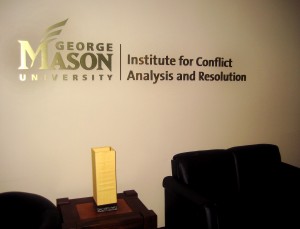
Photo by Annabelle Ombac
“ICAR is smaller than the other George Mason schools, and it does not have as many staff and students,” said Graduate Admissions and Student Services Director Erin Ogilvie. “At the Masters of Science program we have 260 students, and 97 Ph.D. students in total. The admissions program is keeping the ICAR community small because they want small class sizes and a cohort feel to enhance the student experience. It is like a boutique program, a stand-alone unit with a director instead of a dean but we function as a small school [that] has a dean.”
Ogilvie has worked for the school since June of 2006. Although it is a smaller school, ICAR has a functional career center which services its students and alumni.
“ICAR has a community network [that] is an online social network, a Ning.com site,” says Ogilvie. “This is a closed environment for ICAR. These networks are separate because they have very different structures. Some ICAR alumni attend events, but there is not much of an active alumni chapter, rather, it is more of an involved network.”
“Each semester there are résumé clinics, and I join Duane Bradshaw to review résumés and offer recommendations,” said Ogilvie. This service is open to SPP and ICAR students. We collaborate mostly with the SPP students. There are occasions when students need specific information so one career center worker will call [his or her] respective career center.”
“I meet once a month with other student directors at the Law School and the School of Public Policy, and we meet with Lori Cohen, University Life director for Arlington Campus. Then we meet other representatives to discuss what we are doing on the departmental level,” she continued.
“Many of our events are open to the entire Arlington community. The primary challenge for student interaction is that many of the students are working full time and they then come to take courses late in the evening. Also, each school has its own community. Students identify with their unit more than their campus. When we speak with Lori Cohen, we try to find events where all the students can come together, because . . . the structure can be compartmentalized.”
“I think things have been getting better over the past four years, with events such the Pizza and Perspectives events, which Lori Cohen initialized; students can get together and talk about topics that are of interest to the ICAR, Law and SPP students. There were about three events this spring semester, and they were all successful.”
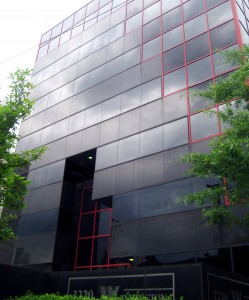
The ICAR building looms above.... Photo by Annabelle Ombac
Ryan Dunn, Stylus Correspondent
Up Close and Personal: GMU School of Law
August 8, 2010
Now and Then – A Profile of the GMU School of Law
The still silence that I had expected turned out to be a studious low hum of students collected in small groups. It perforated throughout the hall upon entering George Mason University’s School of Law.
The School of Law resides in a uniquely shaped, four-story building sitting at the corner of Mason’s Arlington Campus. Within its hallowed walls sits Christine Malone, the director of Student Academic Affairs. Malone, a graduate of the School of Law in 2000, was a law clerk for two years for Fairfax Circuit Court Judge Leslie M. Alden (also a Mason Law alum) and practiced litigation after that at Richards, McGettigan, Reilly, & West. She moved back to Mason in 2004 to assist the Career Services office and to support the school’s second-year Legal Research, Analysis and Writing program. She also co-taught an appellate advocacy course and worked in the alumni office before holding her current position for the past three years.
Mason’s School of Law was actually started as the International School of Law by Dean John W. Brabner-Smith in 1972, and was originally located in Washington, D.C. The International School of Law relocated to Arlington, Va. in 1977 and in 1979, there was a push to merge with Mason. The School of Law, which once resided in the Original Building where the School of Public Policy is now located, integrated with the rest of the programs later that year. In January 1999, it moved across the parking lot to a new building in Arlington (later named Hazel Hall), which contains four stories of classrooms and administrative offices, a three-story library and two levels of parking.
The school contains upwards of 800 students, and the incoming class last fall contained 247 students. The student body is a diverse community: There are slightly more males (53 percent) than females (47 percent). Students come from all walks of life: some enter straight out of undergrad, while others are older, looking for a second career. Many enter the full-time program, in which you can work no more than 20 hours outside the law program. There are various groups that students are able to take part in that represent different political, religious and ethnic backgrounds, and students can take advantage of community life through, for example, events such as happy hours.
The student body is small enough that students can maintain close relationships with their professors and with each other. Students are divided up into sections, and will stay with that section until they finish the program. The School of Law has one of the highest bar exam passage rates in the State of Virginia, clocking in at 90.6 percent, ten points higher than the state average.
After inquiring how the School of Law fits in with the overall Arlington Campus community, Malone remarked how it’s a challenge for the community to come together. There are very different programs and you have full-time students versus part-time students on campus; the difficulty is that everyone does different things. The School of Law offers opportunities that are available for all students. One advantage is that there are many ways in which law and policy overlap, which can potentially lead to a closer community, and the new building may offer ways of bringing the two groups closer together.
“If there is a law student sitting outside at a table and the people next to them are public policy students, somebody might hear something and engage in conversation, and that just doesn’t happen that much right now,” said Malone. We’re all sort of in our own little spaces.”
Despite the spaces, the Law Library and its resources are a shared facility. “The library is three stories tall and contains 488,994 volumes,” said Deborah Keene, the dean of the Law Library.
However, with all this space, they still didn’t have enough room for their entire collection, and the Original Building library still houses some volumes. Most importantly, the library is open for access to all students at Mason and the public at large. Public Policy students can visit the library at any time and take advantage of their large collection of material, as well as their various databases and labs.
Why should a prospective student think about Mason’s School of Law? The tight-knit community and small class sizes allow for plenty of interaction with colleagues and professors. The professors are open to their students, and maintain great relationships with them, participating in various events the school holds, including an event where the professors were dealers for a casino night and all the money went to charity. The School of Law maintains an excellent reputation outside of its walls, and its unique perspective on law make it a school where you can truly get the best “bang for your buck” and receive an excellent preparation for practicing law.
Daniel Jeskey, Stylus Correspondent
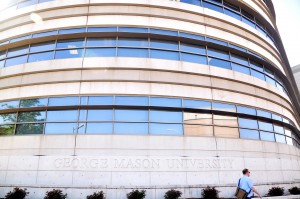
Walkin' by GMU School of Law...Can't Miss it! Photo by Annabelle Ombac
Mercatus Center Flourishes Under Mason Alumnus
August 8, 2010
Renowned professor of economics talks to The Stylus
Tyler Cowen’s professional career developed and centered on his experiences at George Mason University. In 1983, Cowen achieved a B.S. from George Mason University in Economics. He then went to Harvard University for both his graduate and Ph.D. degrees, also in Economics.
He worked until 1989 as an assistant and associate professor of economics at the University of California, Irvine and then returned to Mason. In 1998, Mason Provost David Potter appointed Cowen as general director of both the Mercatus Center and the James M. Buchanan Center for Political Economy. In 2000, Dr. Cowen was named the Holbert C. Harris Chair of Economics. He also serves on the Mercatus Center’s Board of Directors.
Dr. Cowen has enjoyed the chance to help create an exciting intellectual environment at the Mercatus Center. “We have been at George Mason University for over 30 years and it has been a fruitful relationship,” said Cowen. The center largely focuses on economics, so its studies cover many areas in relation to law and public policy. According to its website, the Mercatus Center is “a university-based research center [that] works to advance knowledge about how markets work to improve our lives by training graduate students, conducting research and applying sound economics to offer solutions to society’s most pressing problems.”
The Mercatus Center’s information and research can be beneficial to students in many programs at George Mason University. In addition, students also have access to the information supplied by the research center, and the ability to apply for scholarship opportunities.
Recent Mercatus research has focused on Africa, which Cowen described as a “major issue” because of the continent’s high poverty levels. He would also agree with the idea that wealth and prosperity bring democracy.
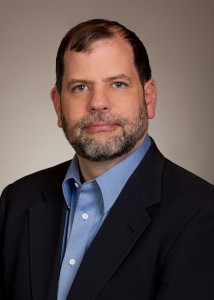
Dr. Tyler Cowen Photo Courtesy of Dr. Tyler Cowen
Ryan Dunn, Stylus Correspondent
Bee tea dubs, Dr. Cowen and Dr. Alex Tabarrok,
another Mason Economics professor, have a popular blog.
Check it.
www.marginalrevolution.com
The Winner Is…
August 8, 2010
In it to win it
Dr. Rozell was not the only award winner at the Signature Event. SPP students Andro Gigauri and Behnaz Bonyadian took home the coveted Distinguished Student Awards. Andro graduated this past May with his Masters in Public Policy (MPP), while Behnaz is a current MPP student focusing on Global Governance and International Institutions. So what does it take to get this honor bestowed upon you? Well lucky for you The Stylus has established a way to prepare yourself for next year’s award.
Step 1: Like your professors
Both Gigauri and Bonyadian expressed their relationships with their professors as reasons for their success at SPP.
Bonyadian focused on the effect professors have had on her overall experience: “I have had a great first year both academically and personally with my professors.”
Gigauri was happy to name Dr. Rudder as one of the reasons for his success. “She has a reputation as being a tough professor,” he said. “And a tough professor she is, but I [learned] the most in her class. She pushes me to the edge. That makes me want to learn more.”
Step 2: Get involved on campus
Bonyadian highlighted that she thought volunteer experience on top of her full-time course load and work schedule was what set her apart from the rest of the award nominees.
Gigauri spoke of the importance of having a community at the Mason Arlington Campus and of contributing to this during his time as a student here.
Step 3: You’ve got to have goals
Gigauri will be graduating this spring and plans to join the Republic of Georgia civil service. He says leaving Mason will not be easy but he sounds more than enthusiastic about his future plans.
Bonyadian has some time left at Mason: “I look forward to achieving my masters degree, as well as establishing great connections with professors and fellow students. I hope to continue my career in policy making and analysis at a international organization,” says Bonyadian.
The Stylus wishes the both of them the best of luck in their endeavors and congratulates them on their remarkable achievement!
This article was originally written in Spring 2010. Andro Gigauri graduated this past May with his Masters in Public Policy. Behnaz Bonyadian is still a student in the MPP program.
Anne Abbott, Stylus Correspondent
Dr. Rozell receives the SPP Distinguished Professor Award
August 8, 2010
Valuing the GMU approach
This year’s recipient of the SPP Distinguished Professor Award went to Dr. Mark Rozell. Dr. Rozell is currently teaching a section of Public Policy (PUBP) 700 and an elective course on Religion and Public Policy. The Stylus recently got the chance to ask him a few questions regarding both his award and his life at the School of Public Policy (SPP).
The Stylus: What do you like best about Mason’s School of Public Policy?
Dr. Rozell: I value the interdisciplinary approach of SPP. Until I came here in 2004, I never realized just how much I would appreciate working in a policy program with colleagues from various disciplines. It makes for a vibrant atmosphere. Faculty learn from each other and students benefit enormously from this approach.
SPP has a highly successful program because of the good leadership, colleagueship and terrific staff here. Despite the differences among colleagues in fields of specialty, people here work together cooperatively. SPP is one of the rare academic environments where there is almost no factionalism, backbiting and other such nonsense that plagues much of academia. It’s a great environment where people can focus on their work and do what they do best.
If you are contemplating taking a class with Dr. Rozell next semester, you might be interested to know that he does play favorites. I next asked Dr. Rozell the most obvious question you can think to ask a professor:
The Stylus: What is your favorite class to teach?
Dr. Rozell: My favorite class right now is a special topics seminar, “Religion and Public Policy.” I have especially enjoyed leading a seminar on “Media and Public Policy.” Naturally, like all faculty, I get the most charged up about teaching subjects directly related to my own research.
The Stylus: How do you view the professional environment at SPP?
Dr. Rozell: I’m fortunate to be surrounded by some really impressive colleagues. I like that Jeremy Mayer is a solid scholar, enthusiastic teacher, and he also keeps things light and real around here. I like people who are talented but don’t take themselves too seriously.
I am also thrilled watching some of the newer faculty here energize the place in different ways. Keep an eye on Mike Fauntroy; at a remarkably young age, he has soared to a very high level in the competitive world of political analysis. He puts his research out in the public in a way that teaches the broader community about the important findings of political science. Very few academics can do that.
This article was originally written in spring 2010. Please check with SPP for the fall 2010 course schedule if you are interested in taking a class!
Anne Abbott, Stylus Correspondent
Alumni Chapter 2010 Signature Event and Awards
August 8, 2010
A final goodbye to Dr. Francis Fukuyama
The School of Public Policy (SPP) Alumni Chapter sees its mission as ensuring that the best aspects of the Mason experience are available to students long after they graduate. Through awards recognizing SPP faculty, students, and alumni for excellence in teaching, scholarship, and service and its communication efforts, the chapter keeps alumni in the know about SPP-sponsored academic and career-advancing events. Throughout the year, it organizes gatherings like the Signature Event to knit all of us together in the pursuit of actionable knowledge and advancement.
More than 175 alumni, students, faculty and staff were in attendance for this year’s Signature Event.
“The Signature Event provides a unique opportunity for the SPP Alumni Chapter to connect former and current students,” says SPP Alumni President Sarah Bonner. “This year’s dinner was the largest yet and calls attention to the growth of community on campus. When students graduate, we help them to stay connected to the resources and community of SPP. The professional network can be just as valuable as the degree.”
This year’s keynote speaker was American philosopher, political economist, and author Dr. Francis Fukuyama. Fukuyama is the founding director of the School of Public Policy’s International Commerce and Policy (ICP) program.
The Signature Event was the official farewell for Fukuyama as he leaves the D.C. region for the West Coast. A Lifetime Achievement Award was presented to him at this special event. Fukuyama’s speech, titled “American Exceptionalism: Then and Now” was an insightful presentation that provided an enlightening discussion for all in attendance. As part of the Signature Event, several SPP students and faculty were honored.
Andro Gigauri and Behnaz Bonyadian were presented this year’s SPP Alumni Chapter Distinguished Student Awards and Professor Mark J. Rozell was presented the chapter’s Distinguished Faculty Award for his participation in and support of many chapter activities.
A version of this article can be found in the April 2010 SPP Currents.
Adam Tabaka, Special to The Stylus
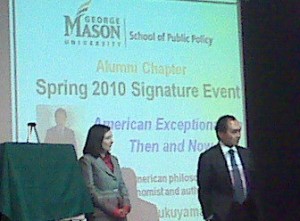
Dr. Fukuyama talks about American Exceptionalism at the SPP Alumni Dinner. Also pictured: SPP Alumni President, Sarah Bonner Photo by Angham Ali
Does Journalism Need a Blood Transfusion?
August 8, 2010
Panel of experts address deepening crisis facing old media
The news media is on life-support and beginning to flat-line.
Tremendous ad revenue losses, spurred by a public who increasingly refuse to pay for content, has resulted in consumers being less likely to view traditional media as an authoritative source on all matters.
Not so fast, indicate the speakers at Transforming Journalism: The State of the News Media 2010, held at The George Washington University’s School of Media and Public Affairs (SMPA).
The March 29 event, sponsored by The Newseum and the Pew Research Center’s Project for Excellence in Journalism, explored the current state of the media coinciding with the release of the “State of the News Media” report.
The opening panel discussion, moderated by former George Mason University professor and current SMPA Director Dr. Frank Sesno, offered insight into journalism’s future by stating that the news media can weather the storm but “hand wringing” will not help.
Among the charges held against the mainstream media is an increased trend towards partisanship.
Tom Rosenstiel, director of Pew’s Project for Excellence in Journalism, noted that “the news is more of an argument and less of an authoritative finished product.” Rosenstiel continued, “Just in the last couple years we’ve seen a rise in distrust [in the media] again . . . much of it actually from liberals who think that the press has become more biased than they were.”
The merging of entertainment with hard news isn’t going away any time soon, either.
“You have to regard yourself as putting on a show, ” said Tina Brown, former editor of The New Yorker and founder of The Daily Beast. The major enemy that we all have is time famine. Make them pay attention. If they didn’t read anything, you failed.”
“Never before in human history has so much information been available to so many people, so quickly,” said Dr. Sesno. The information overload leaves consumers of media with many options of finding out information, yet there is no consensus on what the day-to-day news events really mean.
Jim Brady, president of Digital Strategies for Allbritton Communications and a panelist at the GW event, sees mobile phone content as the next big undeveloped territory. Yet it seems the news media are preparing for these changes by focusing on increasing their own reach through mobile media, news aggregators, blogs and Twitter feeds, rather than leading the way by innovating new ways of distribution.
“If you are looking at like traffic alerts and weather alerts [while you’re] approaching 495 and the phone [tells] you that you’re about to approach a huge traffic jam, maybe you ought to make a left,” said Brady. “I mean, if I got saved twice a year by those alerts, I’d pay a pretty good chunk of change for it.”
The information provided by social, or “new” media, created by loosely connected citizen journalists, offers a taste of what the new media model may look like. Yet there is an interesting counterpoint to this shift.
“When do we stop calling it new? I’ve been doing what I’ve been doing for 10 years,” said Ana Marie Cox, GQ Magazine’s Washington, D.C. correspondent. The mainstream media dominates the debate about itself by framing its competitors as a passing trend, yet it usurps those ways of distribution to further its own ends. Without the media to determine what is on the agenda, perhaps the public is better suited towards deciding what should be on the day’s agenda.
“You can’t assign a citizen journalist to do something; they have to want to cover it,” said Cox.
The pay-per-story model, announced by The New York Times this year, could change the way we consume news, yet there is likely to be a resistance towards paying for content online by consumers who have been reading it free online for years.
Falling revenue streams face not only corporate news outlets, but the public ones as well. The news media is “wounded in that area, but not killed,” said Vivian Schiller, president of NPR news during the event’s keynote speech.
“The losses suffered in traditional news gathering in the last year were so severe . . . they overwhelm the innovations in the world of news and journalism,” said Schiller.
Yet Schiller ended her keynote with an optimistic message to the students attending about how the future of the news media will occur: “You will be the ones to create what those of us [who] have brains that are just too old will ever figure out.”
George Mocharko, Stylus Staff Editor
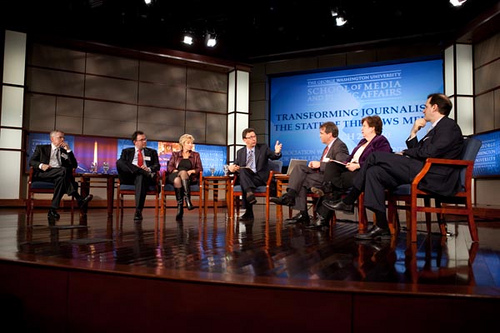
Jim Brady, President, Digital Strategies, Allbritton Communications Company, Tina Brown, Founder and Editor-in-Chief, The Daily Beast; Susan Page, Washington Bureau Chief, "USA Today"; Antoine Sanfuentes, Senior Vice President and Washington Bureau Chief, NBC News, Vivian Schiller, President and CEO, National Public Radio (Keynote); Charlie Sennott, Executive Editor, "GlobalPost" Photo Courtesy by The School of Public & Media Affairs, The George Washington University